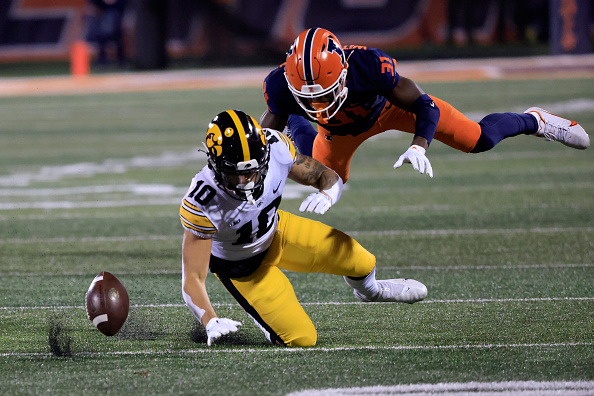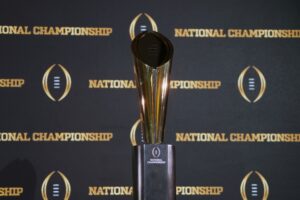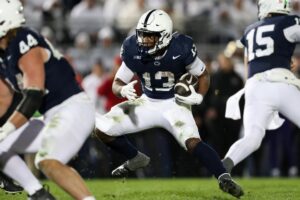The historically inept, and quite frankly unacceptable, offensive play that Iowa continues to exhibit was on display again in Champaign. The Hawkeyes reached the red zone just three times on 13 drives in a 9-6 loss to Illinois. One of those red zone trips was the result of a fumble recovery at the five-yard line. Somewhat unsurprisingly, it was a possession that did not end in a touchdown. Still, the Illini have yet to allow a touchdown inside their home stadium.
If there’s one sequence of events that perfectly describes the dysfunction that exists within Iowa’s offense, it happened near the end of the second quarter against Illinois. A Hawkeye punt to the Illini was muffed and immediately recovered by Jack Campbell. Iowa took over at the Illinois 35-yard line. The offense proceeded to lose six yards and punt back to Illinois. On the second play of the new Illini drive, Riley Moss forced a fumble on a tackle for loss, giving Iowa the ball back at the Illinois five-yard line. It was one of many big plays in a great game by Iowa’s defense. Then, after a rush for loss and an unsportsmanlike penalty on Iowa, the Hawkeyes were forced to settle for a field goal. Ultimately, it was a two-possession sequence that somehow gained 70 yards despite -10 yards of offense, resulting in three points.
Red Zone Ineptitude
Things started out positive on Iowa’s first drive of the game. The team drove 10 plays for 59 yards into the Illini red zone. The drive consisted of two third and long conversions on pass plays to Sam LaPorta for 30-plus yards. Iowa reached the Illinois seven-yard line, and then things fell apart. A rush for loss, a pass for loss, and a false start backed the Hawkeyes up to the 14-yard line. Then, the ensuing play call was an ultra-conservative run up the middle that felt like a field goal was the intention. Iowa settled for three. Of the other two red zone appearances, one was the aforementioned fumble fiasco. The other included a loss of yards backing them out of the red zone resulting in a missed field goal.
When the field gets condensed inside the red area, things have been brutally inconsistent for the Hawkeyes this season. Iowa is dead last in the conference and bottom five nationally in each of the following categories: Red zone attempts (12), red zone scores (8), and red zone touchdown percentage (33%). On 75 offensive drives this season, just 12 have reached the red zone, and four resulted in touchdowns.
Play Calling and Negative Yardage
Play Calling
On several occasions in Champaign on Saturday, Iowa’s offensive playcalling looked unreasonably poor. It showed the most on drives where the pass game was clicking. In the final minute of the second quarter, Spencer Petras connected with Nico Ragaini and LaPorta. It was an offensive drive that reached the Illinois 18-yard line at one point. However, two play calls stood out as wildly unnecessary. Following a deep pass completion on third down to midfield, Iowa elected to run the ball up the middle with the clock running under one minute. The gain of zero yards was followed up with a timeout. A play that never had a chance wasted a handful of seconds and a fresh set of downs. It’s difficult to understand the goal of that sequence. Why run a throw-away play and waste a timeout?
On that same drive, following another deep pass of 32 yards, the Hawkeyes were set up inside the Illini red zone. At the 18-yard line following an incompletion, Iowa drew up a trick play, end-around resulting in a loss of nine yards. The play resulted in 3rd and 19, forcing Iowa to take another timeout. The Illini have one of the better run defenses in the nation, and Petras had been successful with passes on this particular drive. Why is an end-around play call the decision at this point? Not to mention, this play was called during a two-minute offense with 21 seconds left in the quarter.
The Result
Iowa is not known for being a hurry-up team, but they were stringing together a decent two-minute drive. Calling a low-percentage run play puts the team in a situation where a failure guarantees the use of a timeout and worsens field position. The incompletion on the previous play stopped the clock. That pseudo-timeout should have been enough for Iowa to regroup. Instead, offensive coordinator and play caller Brian Ferentz essentially threw away another play.
This drive ended with a missed 45-yard field goal. However, it’s a miss that is hard to put on the kicker. The Hawkeyes were inside the red zone on this drive, and poor situational play-calling forced a tough kick. Settling for three after a largely successful drive does not win these kinds of low-scoring games. A touchdown has to be the goal, but the plays drawn up suggest otherwise.
Negative Yards
The Illini defense had an outstanding performance against the Hawkeyes. The team registered 11 tackles for loss on 66 Iowa plays. Nearly 17% of Iowa’s offensive snaps resulted in a loss of yards. The 11 tackles for loss totaled 61 yards in the wrong direction for Iowa. Again, the Hawkeyes found themselves in a hole that they could not dig out of.
In the first half, Iowa had the ball six times. Two of those times were 10-play drives that brought them inside the red zone. The other four were three-and-outs totaling 6, -11, -6, and -4 yards each. Five of Iowa’s 13 possessions on the day ended in negative yards gained, and eight of them consisted of four or fewer plays. The offense is at a point where it is broken beyond the norm of modern-day college football. Middle-tier teams in college football are averaging 21-23 first downs per game. The top teams near 30 per game. The Hawkeyes have 29 combined in their last two games, and average 13 per game, the worst in the entire football bowl subdivision. It becomes very hard to convert first downs when drives begin with negative or zero-yard plays. On 23-second down attempts against Illinois, Iowa’s average distance to go was 9.39 yards.
Iowa Loss to Illinois
The defeat in Champaign on Saturday marked the first loss to the Illini since the 2008 season and the fourth in the Kirk Ferentz tenure. The Hawkeyes have scored just seven offensive touchdowns in six games this season. After the loss, Ferentz was asked about a mid-season offensive coaching change, and if that is something he would consider given the performance all season. A fair question given the consistent lack of production. His response was that he is not considering any changes. In an age where coaching turnover runs rampant with sub-par performance, no coach in the Iowa football program will enter the bye week with a concern for their job.
Going forward, it will be a much-needed bye week for the Hawkeyes at the midway point of the season. A coaching change is not in the question. However, some kind of change will be necessary if Iowa hopes to cover what’s likely to be at least a three-touchdown spread in Columbus in two weeks. Bowl eligibility was riding on this game at Illinois. The loss drops Iowa to 3-3 on the season. The Hawkeyes will be in for a fight to get to six wins by December.






